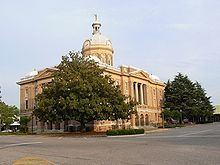Founded December 7, 1866 Area 1,570 km² | Congressional district 3rd Website claycochamber.com Population 13,486 (2013) Unemployment rate 5.5% (Apr 2015) | |
 | ||
Rivers Hatchet Creek, Crooked Creek, Mad Indian Creek Points of interest Cheaha State Park, McDill Point, Talladega Mountain, Hernandez Peak, Cheaha Falls | ||
Clay County is a county of the U.S. state of Alabama. As of the 2010 census the population was 13,932. Its county seat is Ashland. Its name is in honor of Henry Clay, famous American statesman, member of the United States Senate from Kentucky and United States Secretary of State in the 19th century. It was the last dry county in Alabama with no wet cities within its boundaries, until a vote on March 1, 2016 approved the sale of alcohol in Lineville and Ashland.
Contents
- Map of Clay County AL USA
- History
- Geography
- Adjacent counties
- National protected area
- Major highways
- Rail
- Demographics
- City
- Town
- Census designated places
- Unincorporated communities
- Notable people
- Places of interest
- References
Map of Clay County, AL, USA
History
Clay County was established on December 7, 1866 from land taken from Randolph and Talladega counties. Named after the famous statesman Henry Clay, the county seat itself was named after his estate in Lexington, Kentucky called "Ashland". The county was covered with a heavy growth of trees, and a part of the territory was occupied by the Creek Indians. The early pioneers acquired the lands by government entry, and the Indian lands by public auction. The families came wholly from Fayette County, Georgia. Clay County was formed for geographic reasons. The citizens of the area had a difficult time reaching the county seat of Wedowee in Randolph County because of the Tallapoosa River to the east. Talladega was difficult to reach because of the intervening mountains. Even today, Clay County is one of only three counties in Alabama to have no U.S. highways in its boundaries. Ashland was a mining center, particularly for graphite.
During the Desert Shield/Storm conflict, Clay County had more soldiers serving per capita than any other county in the United States.
Geography
According to the U.S. Census Bureau, the county has a total area of 606 square miles (1,570 km2), of which 604 square miles (1,560 km2) is land and 2.0 square miles (5.2 km2) (0.3%) is water.
Adjacent counties
National protected area
Major highways
Rail
Demographics
As of the census of 2010, there were 13,932 people, 5,670 households, and 3,978 families residing in the county. The population density was 23 people per square mile (9/km2). There were 6,776 housing units at an average density of 11 per square mile (4/km2). The racial makeup of the county was 81.7% White(non-Hispanic), 14.8% Black or African American, 0.4% Native American, 0.2% Asian, 0.0% Pacific Islander, 1.2% from other races, and 1.7% from two or more races. 2.9% of the population were Hispanic or Latino of any race.
As of the census of 2000, there were 14,254 people, 5,765 households, and 4,098 families residing in the county. The population density was 24 people per square mile (9/km2). There were 6,612 housing units at an average density of 11 per square mile (4/km2). The racial makeup of the county was 77.62% White(non-Hispanic), 19.70% Black or African American, 0.32% Native American, 0.10% Asian, 0.02% Pacific Islander, 0.46% from other races, and 0.79% from two or more races. 4.77% of the population were Hispanic or Latino of any race.
There were 5,670 households out of which 27.1% had children under the age of 18 living with them, 52.7% were married couples living together, 12.8% had a female householder with no husband present, and 29.8% were non-families. 27.2% of all households were made up of individuals and 11.8% had someone living alone who was 65 years of age or older. The average household size was 2.41 and the average family size was 2.92.
In the county, the population was spread out with 22.6% under the age of 18, 7.8% from 18 to 24, 23.8% from 25 to 44, 28.3% from 45 to 64, and 17.6% who were 65 years of age or older. The median age was 42 years. For every 100 females there were 96.3 males. For every 100 females age 18 and over, there were 96.4 males.
The median income for a household in the county was $35,595, and the median income for a family was $43,392. Males had a median income of $32,382 versus $30,000 for females. The per capita income for the county was $18,332. About 18.5% of families and 18.8% of the population were below the poverty line, including 21.1% of those under age 18 and 15.4% of those age 65 or over.
City
Town
Census-designated places
Unincorporated communities
Notable people
Places of interest
Clay County is home to parts of Cheaha State Park in the Talladega National Forest and Lake Wedowee on the eastern boundary. Outdoor adventures abound in Clay County and the surrounding area. The Pinhoti Trail system weaves its way through the Talladega National Forest to Mt. Cheaha, the highest point in Alabama. Hikers along the trail may spy some of the local wildlife, including whitetail deer, wild turkey, and the rare bald eagle.
Home of Doc Hilt Trails for Off-Highway Vehicles. On May 5, 2010, Doc Hilt Trails was awarded the distinction of being a National Recreation Trail. One of only two private motorized parks in the nation to ever be awarded the NRT designation.
Clay County has two sites listed on the National Register of Historic Places, the Hugo Black House (destroyed, but still listed) and the Clay County Courthouse.
